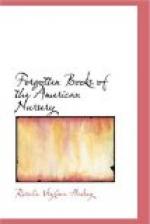The illustrations of Thomas’s toy reprints should not be overlooked. The Worcester printer seems to have rewritten the “Introduction” to “Goody Two-Shoes,” and at the end he affixed a “Letter from the Printer which he desires may be inserted.
SIR: I have come with your copy, and so you may return it to the Vatican, if you please; and pray tell Mr. Angelo to brush up his cuts; that in the next edition they may give us a good impression.”
This apology for the character of the illustrations serves as an introduction to a most interesting subject of conjecture as to the making of the cuts, and particularly as to the engraving of the frontispiece in “Goody Two-Shoes.”
[Illustration: Goody Twoshoes.]
It will be remembered that Isaiah Thomas in his advertisement to booksellers had expressly mentioned the great expense he had incurred in bringing out the juvenile books in “the English method.” But Mr. Edwin Pearson, in his delightful discussion of “Banbury Chap-Books,” has also stated that the wood-cut frontispiece in the first American edition of “Goody Two-Shoes,” printed by Thomas, was engraved by Bewick, the famous English illustrator. A comparison of the reproduction of the Bewick engraving in Mr. Pearson’s book with the frontispiece in Thomas’s edition shows so much difference that it is a matter of regret that Mr. Pearson withheld his authority for attributing to Bewick the representation of Margery Two-Shoes. Besides the inference from Thomas’s letter that the poor cuts would be improved before another edition should be printed, there are several points to be observed in comparing the cuts. In the first place, the execution in the Thomas cut suggests a different hand in the use of the tools; again, the reversed position of the figure of “Goody” indicates a copy of the English original. Also the expression of Thomas’s heroine, although slightly mincing, is less distressed than the British dame’s, to say nothing of the variation in the fashion of the gowns. And such details as the replacing of the English landscape by the spire of a meeting-house in the distance seem to confirm the impression that the drawing was made after, but not by Bewick. In the cuts scattered throughout the text the same difference in execution and portrayal of the little schoolmistress is noticeable. Margery, upon her rounds to teach the farmers’ children to spell such words as “plumb-pudding” “(and who can suppose a better?),” presents her full face in the Newbery edition, and but a three-quarter view to her American admirers.




